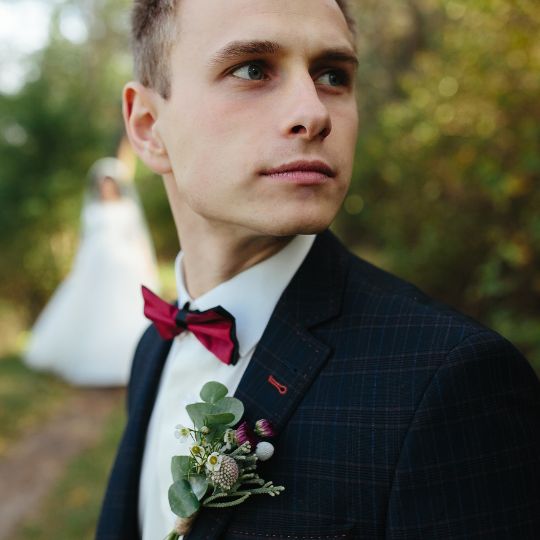The thing I hate most about
traditional weddings
/08
by Jennifer
Cram - Brisbane Marriage Celebrant © 11 April 2024Categories: | Wedding Ceremony | Wedding Traditions |
 It happens in Royal weddings, some
formal church weddings, and every wedding on
#MAFS, and I hate it!
It happens in Royal weddings, some
formal church weddings, and every wedding on
#MAFS, and I hate it!The sight of a bridegroom standing at the altar with his back to the guests while waiting for his bride to join him is a throwback to a time when he likely had never met the bride, or even seen her before gets me in the feels (negatively).
Historically, it was all about two things, one of which has no relevance in a secular, humanist, or celebrant wedding, and the other no relevance to any legal marriage ceremony!
and making sure he didn't catch a glimpse of her was insurance against him legging it!
It's tradition - but
whose?
What we think of as the "traditional" wedding is the way weddings have evolved in Western, Christian, traditional. What I find fascinating is that older ways of "doing a wedding" co-exist with more modern practices, and yet "traditional" is applied across the board, often without differentiation!
One such tradition is the practice of the groom standing with his back to the bride as she makes her entrance, only turning to look at her when she is standing next to him, or, in a slightly more modern twist, when he is given permission by the clergyperson (or celebrant in the #MAFS ceremonies) to turn to look at her.
If you ask "Why?" - and most people don't, you'll likely to be told something like It's a moment filled with anticipation, not just for the groom but for everyone present . Which conveniently ignores the fact that
- In western culture turning your back on anyone is regarded to be rude
- It robs the bride of the nerve-settling view
of the groom's face as she walks towards him
- It robs the groom of the sight of his bride
in all her finery, plus the intimate moment
when they lock eyes
- It robs the guests of the experience of
feeling part of the moment, rather than being
on the outside looking in.
The religious
tradition
Rather, the explanation is simpler. Everyone faced the altar, a practice rooted deeply in the idea of reverence. With the exception of the priest, who faced the congregation as an anointed representative of the church
The darker history
For the bride, there was no choice. The minute she stepped foot inside the church she was deemed to have consented to the marriage, and to everything that came after the wedding, for the rest of her life. The groom, on the other hand, still needed to say the right words as part of the ceremony.
The tradition of not seeing one another the night before the wedding is a holdover superstition from those times.
Can we blame the
silver screen?
Facing the Guests: A
Modern Twist
When couples face one another, the celebrant is likely to step into the position of the priest who was the focus of the ceremony as intermediary between the congregation and the divine, something not relevant in a secular ceremony. Facing one another, however, is promoted as emphasising the personal commitment the couple is making, highlighting the emotional and personal aspects of the ceremony over the traditional or the religious.
I argue, however, that standing side by side, holding hands, shoulder to shoulder, is an intensely intimate position for the couple that also embraces the guests. With the celebrant standing to one side, we are all drawn into a circle of love, of community. When the couple then turns to face one another for their vows, this powerful sense of community is not lost. The circle isn't broken. We embrace them as they commit their lives to one another.
Pros and Cons
While the groom standing with his back to the guests and to his bride as she walks down the aisle might work in a church, it can feel odd in a garden or other venue. It is also highly gendered and therefore a heteronormative choice. If you are a same sex couple you'll want to rethink the whole notion.
The traditional stance, with the couple's back to the guests, does lend a certain gravitas to the ceremony, emphasising the solemnity and the traditional aspect of marriage. Or so those in favour, claim. However, it can also seem somewhat exclusive, leaving guests feeling more like observers than participants in the special moment.
Choosing an alternative for walking down the aisle - perhaps two separate processions, one each, or walking in together, is an inclusive choice.
Facing the guests or each other is a gender-neutral option that makes for a more inclusive and personal experience, potentially fostering a stronger connection between the couple and their guests.
These positions, particularly where the couple faces the guests except during their vows, makes the ceremony feel less formal.
It's about choice

pullin0 Things